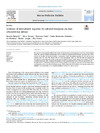Identificador persistente para citar o vincular este elemento:
https://accedacris.ulpgc.es/jspui/handle/10553/107210
| Título: | Evidence of microplastic ingestion by cultured European sea bass (Dicentrarchus labrax) | Autores/as: | Reinold, Stefanie Herrera Ulibarri, Alicia Saliu, Francesco Hernández-González, Carlos Martínez Sánchez, Ico Lasagni, Marina Gómez Cabrera, María Milagrosa |
Clasificación UNESCO: | 310502 Piscicultura 250811 Calidad de las aguas |
Palabras clave: | Pollution Plastic Microparticles Aquaculture Seafood, et al. |
Fecha de publicación: | 2021 | Proyectos: | Evaluación de los riesgos derivados de la contaminación marina por microplásticos | Publicación seriada: | Marine Pollution Bulletin | Resumen: | The presence of microplastics (MPs) in the marine environment is a concerning topic due to the ecotoxicological effects and possible seafood contamination. Data is needed to evaluate human exposure and assess risks, in the context of a healthy and beneficial seafood consumption. While microplastic ingestion by wild fish has been reported since the early 70‘s, farmed fish are rarely investigated. Here, for the first time the presence of microplastics in fish cultivated in the coastal water of Tenerife (Canary Island, Spain) was evaluated. From 83 examined individuals, 65% displayed microplastics in their gastrointestinal tracts, with averages between 0.6 ± 0.8 (SD) and 2.7 ± 1.85 (SD) particles per fish. The total number of microplastics detected was 119. Fibres (81%) and fragments (12%) were the predominant shapes. FTIR analysis showed that fibres were mostly composed by Cellulose (55%) and Nylon (27%), whereas fragments by PE (25%) and PP (25%). | URI: | https://accedacris.ulpgc.es/handle/10553/107210 | ISSN: | 0025-326X | DOI: | 10.1016/j.marpolbul.2021.112450 | Fuente: | Marine Pollution Bulletin [ISSN 0025-326X], v. 168 (112450) |
| Colección: | Artículos |
Citas SCOPUSTM
54
actualizado el 08-jun-2025
Citas de WEB OF SCIENCETM
Citations
45
actualizado el 08-jun-2025
Visitas
213
actualizado el 17-may-2025
Descargas
231
actualizado el 17-may-2025
Google ScholarTM
Verifica
Altmetric
Comparte
Exporta metadatos
Los elementos en ULPGC accedaCRIS están protegidos por derechos de autor con todos los derechos reservados, a menos que se indique lo contrario.
